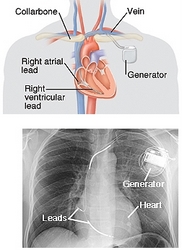Implantable Cardioverter Defibrillator (ICD)
An ICD is a device that is placed permanently inside your body. An ICD monitors your heart rhythm (the speed and pattern of your heartbeat). If this rhythm becomes too fast or too slow, the ICD sends out electrical signals that help bring the rhythm back to normal. The ICD is put inside your body during a minor surgical procedure called implantation. In most cases, implantation takes 1 to 3 hours.

How the ICD Is Put into the Body
The ICD is usually implanted on the left side of your chest. Implantation does not require open heart surgery (your chest will not be opened). During implantation:
- An incision is made in the skin below the collarbone. This creates a “pocket” to hold the ICD.
- A lead (wire) is threaded through the incision into a vein in the upper chest. With the help of x -ray monitors, the lead is then guided into one of the heart’s chambers. Depending on how many leads your ICD has, this process may be repeated to guide leads into other chambers.
- The leads are attached to the heart muscle so they will stay in place.
- The generator (battery) is attached to the leads. Then the generator is placed in its pocket under the skin.
- A fast heart rhythm may be induced (started) to test the ICD.
- When everything else is done, the incision is closed with sutures, medical glue, or staples.
Other Implantation Sites
In some cases, the ICD can be put elsewhere in the body. This could be in the abdomen, on the right side of the chest, or on the left side under the muscle. If one of these is an option for you, your doctor will explain more.
After the Procedure
You’ll stay in the hospital at least overnight. While in the hospital, your heart’s signals are monitored to see how the ICD is working. You can go home when your condition is stable. Once you get home:
- Follow your discharge instructions to care for your incision. Watch for signs of infection (see box).
- Follow any special instructions to care for the side of your body where your ICD was implanted. Your doctor may tell you not to raise that arm above the shoulder for a certain amount of time.
- You’ll likely have bruising at the incision site for about a month. This is normal and will go away as the incision heals.
- You can probably return to your normal routine soon after implantation. Ask your doctor when you can return to work.
- You may be instructed not to drive for a certain amount of time.
- See your doctor for follow-up visits as recommended.
Call Your Healthcare Team If You Have:
- Signs of an infection, such as: fever over 100F; drainage from the incision; redness, swelling, or warmth at the incision site
- Twitching chest muscles
- Pain around your ICD that gets worse, not better
- Bleeding from your incision
- Swelling in the arm on the side of the incision site
- Severe swelling of the incision site (bulging up like a golf ball)
- Chest pain or shortness of breath

